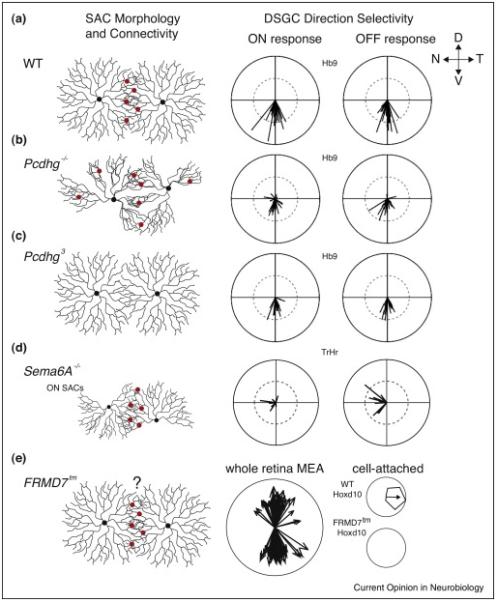Figure 2.

Summary of SAC morphology and connectivity defects in various mutant mouse lines and consequences for direction selectivity. (a) Left: SACs in WT mice have radially symmetric dendrites and form GABAergic synaptic connections onto other SACs. SAC connections onto DSGCs are not pictured. Right: Tuning curve vector sums with amplitude representing strength of tuning and the angle representing the preferred direction. For Hb9-GFP+ DSGCs, which prefer ventral motion, both ON and OFF responses are strongly tuned. Figure adapted from [40••]. (b) SACs in mice lacking the entire γ-Protocadherin cluster do not exhibit self-avoidance, resulting in loss of radially symmetric morphology, and form GABAergic synapses with other SACs, as well as autapses. Both ON and OFF DS responses from Hb9-GFP+ DSGCs are weaker than in WT mice and are not consistently tuned toward the ventral direction. Figure adapted from [40••]. (c) SACs in mice expressing only one γ-Protocadherin isoform have radially symmetric morphology but display little dendritic overlap and rarely form GABAergic synapses with other SACs. Both ON and OFF DS responses from Hb9-GFP+ DSGCs are weaker than in WT but generally tuned to the ventral direction. Figure adapted from [40••]. (d) ON SACs in mice lacking Sema6A do not have radially symmetric morphology, exhibit reduced self-avoidance, and have smaller overall dendritic arbors. They still receive GABAergic inhibition but SAC–SAC connectivity has not been tested. OFF SACs in this mouse have slightly smaller dendritic field areas but are otherwise normal (not shown). In Trhr-GFP+ DSGCs, which prefer nasal motion, ON DS responses are weaker than in WT but generally tuned to the nasal direction, while OFF DS responses remain strongly tuned. Figure adapted from [38••]. (e) SACs in mice with a hypomorphic mutation in FRMD7 have normal morphology, but precise SAC–SAC connectivity has not been tested. Middle: DS responses from MEA recordings of FRMD7tm retina explants show only ventrally and dorsally tuned DSGCs. Right: Hoxd10-GFP+ DSGCs, which prefer temporal motion in WT mice, do not fire action potentials in response to moving bars in FRMD7tm mice. Figure adapted from [44••].
